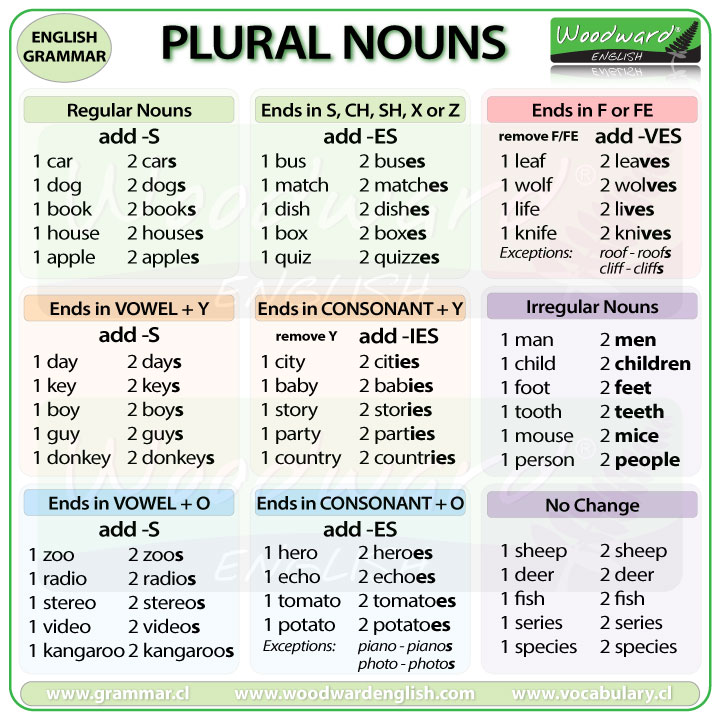In general the plural of a noun is formed by adding -S to the noun.
| Singular | Plural |
|---|---|
| car | cars |
| house | houses |
| book | books |
| bird | birds |
| pencil | pencils |
However:
1. When the noun ends in S, SH, CH, X or Z*, we add -ES to the noun.
| Singular | Plural |
|---|---|
| kiss | kisses |
| wish | wishes |
| match | matches |
| fox | foxes |
| quiz | quizzes* |
- I have a box in my bedroom.
- I have three boxes in my bedroom.
* With words that end in Z sometimes we add an extra Z to the plural form of the word (such as with the plural of quiz).
2. When the noun ends in a VOWEL + Y, we add -S to the noun.
| Singular | Plural |
|---|---|
| boy | boys |
| holiday | holidays |
| key | keys |
| guy | guys |
3. When the noun ends in a CONSONANT + Y, we remove Y and add -IES to the noun.
| Singular | Plural |
|---|---|
| party | parties |
| lady | ladies |
| story | stories |
| nanny | nannies |
| city | cities |
4. If the noun ends in F or FE, we remove the F/FE and add -VES to the noun.
| Singular | Plural |
|---|---|
| life | lives |
| leaf | leaves |
| thief | thieves |
| wife | wives |
Some exceptions: roof - roofs, cliff - cliffs, chief - chiefs, belief - beliefs, chef - chefs
5. If the noun ends in a CONSONANT + O, we normally add -ES to the noun.
| Singular | Plural |
|---|---|
| tomato | tomatoes |
| potato | potatoes |
| echo | echoes |
| hero | heroes |
Some exceptions: piano - pianos, halo - halos, photo - photos
NOTE: Volcano has two correct forms of plural. Both volcanos and volcanoes are accepted.
6. There are a number of nouns that don't follow these rules. They are irregular and you need to learn them individually because they don't normally have an S on the end.
| Singular | Plural |
|---|---|
| man | men |
| woman | women |
| child | children |
| foot | feet |
| tooth | teeth |
| goose | geese |
| mouse | mice |
- There is a child in the park.
- There are many children in the park.
7. There are some nouns in English that are the same in the singular and the plural.
| Singular | Plural |
|---|---|
| fish | fish |
| sheep | sheep |
| deer | deer |
| moose | moose |
| aircraft | aircraft |
- I can see a sheep in the field.
- I can see ten sheep in the field.
Sometimes you will hear the word fishes (especially in songs) though it is grammatically incorrect.
Summary Chart
The following is a summary chart of basic plural noun rules:
The next rules are a lot more advanced and even native speakers have difficulty with these. Unless you are an advanced student, I wouldn't recommend learning them just now.
8. If the noun ends in IS, we change it to ES. Words that end in IS usually have a Greek root.
| Singular | Plural |
|---|---|
| analysis | analyses |
| basis | bases |
| crisis | crises |
9. If the noun ends in US, we change it to I. Words that end in US usually have a Latin root.
| Singular | Plural |
|---|---|
| cactus | cacti |
| fungus | fungi |
| stimulus | stimuli |
| syllabus | syllabi |
Some exceptions: octupus - octupuses (because it is from Greek, not Latin), walrus - walruses









0 Comments